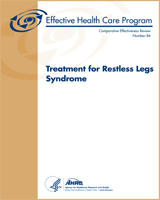Treatment for Restless Legs Syndrome
Comparative Effectiveness Reviews, No. 86
Authors
Investigators: Timothy J Wilt, MD, MPH, Roderick MacDonald, MS, Jeannine Ouellette, James Tacklind, BS, Imran Khawaja, MD, Indulis Rutks, BA, Mary Butler, PhD, MBA, and Howard A Fink, MD, MPH.Affiliations
Structured Abstract
Context:
Restless legs syndrome (RLS) is a neurological disorder characterized by unpleasant sensations in the legs and a distressing, irresistible urge to move them. RLS severity and burden vary widely, and the condition may require long-term treatment.
Objective:
To review the comparative effectiveness, efficacy, and safety of pharmacologic and nonpharmacologic treatments for RLS.
Data sources:
We searched bibliographic databases MEDLINE (via OVID), Embase, and Natural Standards through June 2012.
Review methods:
Eligible efficacy studies included randomized controlled trials (RCTs) of individuals with RLS published in English that lasted at least 4 weeks and compared pharmacologic and/or nonpharmacologic treatments with placebo or active treatment. We assessed RLS symptom impact, sleep scale scores, disease-specific quality of life, withdrawals, and adverse effects. We included observational studies that assessed long-term (>6 months) treatment adverse effects and withdrawals.
Results:
Of the 53 studies included, one active comparator and 33 placebo-controlled RCTs provided efficacy and harms data, and 18 observational studies assessed long-term harms and adherence. RCTs were typically small and of short duration, and enrolled adult subjects with severe primary RLS of long duration. Placebo-controlled RCTs (18 trials) demonstrated that dopamine agonists (pramipexole, rotigotine, ropinirole, and cabergoline) increased the percentage of subjects who had a clinically important response defined as ≥50 percent reduction from baseline in mean International RLS symptom scale scores (IRLS responders) (risk ratio [RR]=1.60; [95% confidence interval [CI]: 1.38 to 1.86], k=7), improved RLS symptom scores, patient-reported sleep scale scores (effect size=0.38; [95% CI: 0.29 to 0.46], k=8), and disease-specific quality of life (effect size=−0.37; [95% CI: −0.48 to −0.27], k=9). Dopamine agonists resulted in more patients who experienced at least one adverse event (high-strength evidence for all outcomes). Long-term augmentation (drug-induced worsening of symptoms) and treatment withdrawal were common. Alpha-2-delta ligands (gabapentin enacarbil, gabapentin, and pregabalin) increased the number of IRLS responders (RR=1.66; [95% CI: 1.33 to 2.09], k=3, high strength of evidence) and mean change in IRLS symptom scores (k=3, high strength of evidence). Intravenous ferric carboxymaltose reduced IRLS symptom scale scores versus placebo (k=1, moderate strength of evidence). Four studies assessed nonpharmacologic interventions. Compression stockings but not the botanical extract valerian improved IRLS symptom scale scores more than sham or placebo treatments. Strength of evidence was moderate for compression stockings and low for valerian. Exercise improved symptoms more than control (low-strength evidence). Near-infrared light treatment improved IRLS symptom scores more than sham (low-strength evidence). Two trials compared active treatments. In one small crossover trial, pramipexole and levodopa/benserazide resulted in similar improvements in IRLS scores (low-strength evidence). Cabergoline improved IRLS scores and resulted in less augmentation than levodopa (moderate-strength evidence). Iron improved symptoms in adults with iron deficiency (k=2) (low-strength evidence). No studies enrolled pregnant women, children, or those with end-stage renal disease. Withdrawal from mostly dopamine agonist and levodopa treatment at 1 year or more ranged from 13 to 57 percent. Treatment withdrawals were due to lack of efficacy (6% to 37%) as well as augmentation and other adverse events.
Conclusion:
Compared to placebo, dopamine agonists and alpha-2-delta ligands reduce RLS symptoms and improve patient-reported sleep outcomes and disease-specific quality of life. Adverse effects of pharmacologic therapies and long-term treatment withdrawals due to adverse effects or lack of efficacy are common. Long-term effectiveness as well as applicability for adults with milder or less frequent RLS symptoms, individuals with secondary RLS, and children is unknown.
Prepared for: Agency for Healthcare Research and Quality, U.S. Department of Health and Human Services1, Contract No. 290-2007-10064-I, Prepared by: Minnesota Evidence-based Practice Center, Minneapolis, MN
Suggested citation:
Wilt TJ, MacDonald R, Ouellette J, Tacklind J, Khawaja I, Rutks I, Butler M, Fink HA. Treatment for Restless Legs Syndrome. Comparative Effectiveness Review No. 86. (Prepared by the Minnesota Evidence-based Practice Center under Contract No. 290-2007-10064-I.) AHRQ Publication No. 12(13)-EHC147-EF. Rockville, MD: Agency for Healthcare Research and Quality. November 2012. www.effectivehealthcare.ahrq.gov/reports/final.cfm.
This report is based on research conducted by the Minnesota Evidence-based Practice Center (EPC) under contract to the Agency for Healthcare Research and Quality (AHRQ), Rockville, MD (Contract No. 290-2007-10064-I). The findings and conclusions in this document are those of the author(s), who are responsible for its contents, the findings and conclusions do not necessarily represent the views of AHRQ. Therefore, no statement in this report should be construed as an official position of AHRQ or of the U.S. Department of Health and Human Services.
The information in this report is intended to help health care decisionmakers—patients and clinicians, health system leaders, and policymakers, among others—make well-informed decisions and thereby improve the quality of health care services. This report is not intended to be a substitute for the application of clinical judgment. Anyone who makes decisions concerning the provision of clinical care should consider this report in the same way as any medical reference and in conjunction with all other pertinent information, i.e., in the context of available resources and circumstances presented by individual patients.
This report may be used, in whole or in part, as the basis for the development of clinical practice guidelines and other quality enhancement tools, or as a basis for reimbursement and coverage policies. AHRQ or U.S. Department of Health and Human Services endorsement of such derivative products or actions may not be stated or implied.
None of the investigators have any affiliations or financial involvement that conflicts with the material presented in this report.
- 1
540 Gaither Road, Rockville, MD 20850; www
.ahrq.gov
